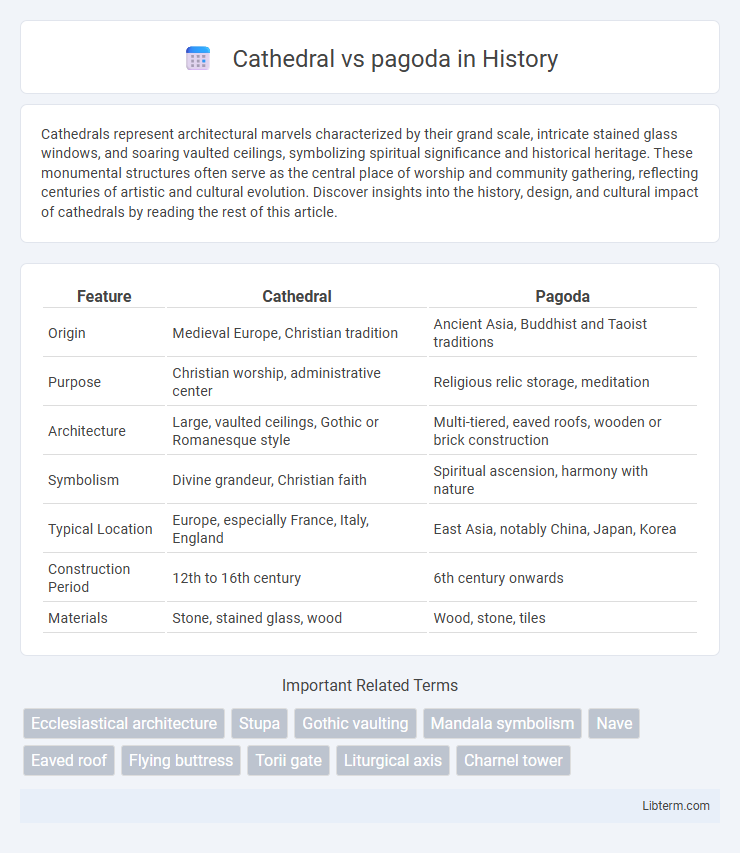Cathedrals represent architectural marvels characterized by their grand scale, intricate stained glass windows, and soaring vaulted ceilings, symbolizing spiritual significance and historical heritage. These monumental structures often serve as the central place of worship and community gathering, reflecting centuries of artistic and cultural evolution. Discover insights into the history, design, and cultural impact of cathedrals by reading the rest of this article.
Table of Comparison
| Feature | Cathedral | Pagoda |
|---|---|---|
| Origin | Medieval Europe, Christian tradition | Ancient Asia, Buddhist and Taoist traditions |
| Purpose | Christian worship, administrative center | Religious relic storage, meditation |
| Architecture | Large, vaulted ceilings, Gothic or Romanesque style | Multi-tiered, eaved roofs, wooden or brick construction |
| Symbolism | Divine grandeur, Christian faith | Spiritual ascension, harmony with nature |
| Typical Location | Europe, especially France, Italy, England | East Asia, notably China, Japan, Korea |
| Construction Period | 12th to 16th century | 6th century onwards |
| Materials | Stone, stained glass, wood | Wood, stone, tiles |
Architectural Distinctions: Cathedral vs Pagoda
Cathedrals showcase Gothic or Romanesque architecture characterized by flying buttresses, pointed arches, and expansive stained glass windows, emphasizing verticality and light. Pagodas feature tiered, multi-eaved roofs with upward-curving edges, rooted in East Asian Buddhist design, symbolizing sacred mountains. The structural materials differ as well: cathedrals primarily use stone and glass, whereas pagodas often incorporate wood and ceramic tiles.
Historical Origins and Cultural Contexts
Cathedrals originated in medieval Europe as central churches of Christian dioceses, primarily built during the Romanesque and Gothic periods to symbolize religious authority and the glory of God. Pagodas emerged in East Asia, influenced by Buddhist stupas from India, serving as religious monuments with multiple tiers representing sacred mountains and spiritual ascent. The architectural styles reflect differing cultural values: cathedrals emphasize verticality and light to inspire worshippers, while pagodas integrate local aesthetics and spiritual symbolism rooted in Buddhist traditions.
Symbolism and Religious Significance
Cathedrals symbolize Christian faith and serve as central places for worship, embodying the presence of God and the church's authority. Pagodas reflect Buddhist principles, often representing sacred relics or spiritual enlightenment, with their tiered structures symbolizing the path to nirvana. Both architectural forms convey profound religious significance through their design, rituals, and cultural contexts.
Core Structural Elements
Cathedrals feature massive stone walls, flying buttresses, and large stained glass windows to support vaulted ceilings and create vertical emphasis. Pagodas consist of multiple tiers with eaves that curve upwards, built primarily from wood with interlocking brackets designed to absorb seismic activity. Both structures use core elements that reflect their cultural and functional purposes, with cathedrals emphasizing monumental height and light, while pagodas prioritize tiered stability and flexibility.
Materials and Construction Techniques
Cathedrals primarily utilize stone, such as limestone and granite, employing techniques like ribbed vaults and flying buttresses to achieve high ceilings and large stained-glass windows. Pagodas are traditionally constructed with wood, featuring intricate joinery and layered eaves designed to provide flexibility and resistance to earthquakes. The contrasting materials and construction methods reflect their distinct cultural contexts and functional requirements, with cathedrals emphasizing verticality and light, while pagodas focus on structural resilience and aesthetic harmony.
Iconography and Artistic Details
Cathedrals often feature Gothic iconography, including stained glass windows depicting biblical scenes, elaborate stone carvings of saints, and intricate vaulted ceilings symbolizing divine ascent. Pagodas incorporate Buddhist iconography, such as tiered roofs representing spiritual layers, lotus motifs symbolizing purity, and ornate wooden carvings of dragons or deities reflecting protection and enlightenment. Artistic details in cathedrals emphasize verticality and light to evoke transcendence, whereas pagodas focus on symmetry and natural integration to convey harmony and spiritual balance.
Regional Variations and Influences
Cathedrals, primarily found in Western Europe, reflect Gothic, Romanesque, and Baroque architectural styles influenced by Christian religious traditions and local cultural elements. Pagodas, widespread across East Asia in countries like China, Japan, and Vietnam, exhibit multi-tiered towers rooted in Buddhist spiritual practices, integrating regional materials and craftsmanship. The distinct structural forms and decorative motifs of cathedrals and pagodas demonstrate how geography and religious belief shape architectural evolution in different regions.
Role in Community and Worship
Cathedrals serve as central places of worship in Christian communities, often acting as the seat of a bishop and hosting significant religious ceremonies, community events, and social gatherings. Pagodas, rooted in Buddhist traditions, function primarily as places for meditation, house sacred relics, and symbolize spiritual ascent, playing a key role in fostering monastic and lay community interactions. Both structures influence their communities by providing spiritual centers that support religious practices, cultural identity, and communal cohesion.
Preservation and Modern Adaptations
Cathedrals, often constructed with stone and intricate stained glass, undergo meticulous preservation efforts emphasizing structural integrity and historical authenticity, frequently incorporating modern climate control and lighting systems to enhance visitor experience. Pagodas, typically made of wood and layered roofing, require specialized preservation techniques to combat weathering and seismic activity, with modern adaptations including reinforced frameworks and fire-resistant materials to ensure longevity. Both architectural forms balance maintaining cultural significance while integrating contemporary technologies for sustainability and educational accessibility.
Comparative Impact on Tourism and Heritage
Cathedrals attract millions of global tourists annually due to their architectural grandeur and historical significance in Christian heritage, often serving as central landmarks in European cities. Pagodas draw visitors primarily in East and Southeast Asia, offering unique spiritual experiences through their tiered structures and Buddhist cultural associations, enhancing regional tourism. Both structures contribute substantially to heritage preservation and local economies, yet cathedrals tend to have a broader international appeal, while pagodas foster deep cultural tourism within specific Asian contexts.
Cathedral Infographic

 libterm.com
libterm.com